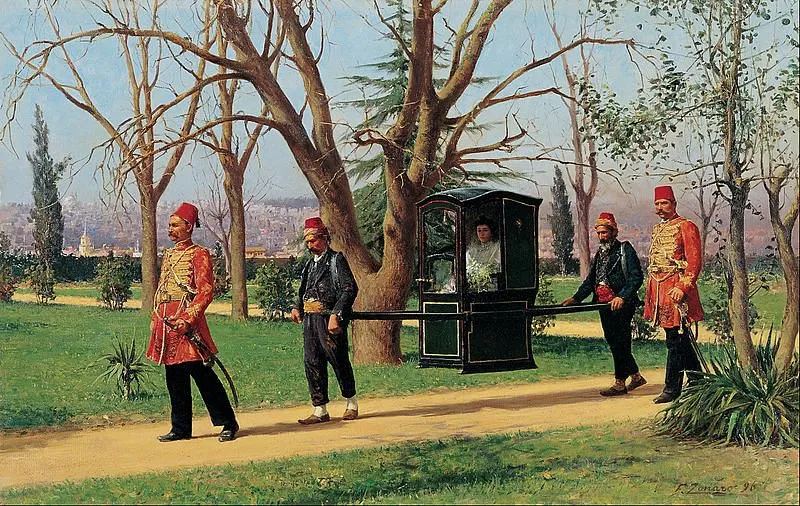The custom of Zapan originated among the royal rulers of Kashmir since ancient times. Royal ladies were usually not to be seen in public. They would travel in cots that were covered and decorated. Even during British rule in India, most of the British ladies used cot (palki) an alternate to Zapan to show off their status. It was also well used in the subcontinent also during Mughal rule and colonial times.
Zapan was made up of Qiro wood. It was 3 feet high and 3 feet wide box like structure which was famous for its durability and nice finish. A rectangular plank of wood fastened on two finished logs served as base for it.
Made by the carpenters in those days, Zapan would appear a small room like space to accommodate a bride. This casing had an opening on one side which functioned as a door with a small window called roshandan (ventilator). The space was covered outwardly with a red colored cloth which used to be the favorite color of brides once.
The base of this palanquin was covered either with blanket or mattress with a pillow kept behind the bride for the easy journey towards her matrimonial home. The skilled carpenters would either keep the right side or the front side of the Zapan as the door for the bride.
However, the preferred exit opening was the front side. It required mastery to carve a Zapan out. Zapan was arranged for the bride only, and for the bridegroom a horse was kept ready because those days there was no transport available.
It was the family of a bridegroom that arranged Zapan for the bride. Then it was dispatched to bride’s house ahead of bridegroom’s arrival. But in most of the occasions, it would go along with Barat.
Tradition was that anybody could shoulder Zapan, however, only the close relatives of the bride were give chance to carry bride towards her in-laws.
Those who carried the bride to her in-laws in the palanquin were called Qahars (palanquin bearers). Earlier there used to be four palanquin bearers to take bide towards her new home because palanquins used to be big in size which could accommodate three brides. As time went by, it became small and and light.
On certain occasion, ‘qahars’ on reaching the destination would refuse to bring down the Zapan as they would demand bakchayish (tip) from the bridegroom. These palanquin bearers during their travel would sing songs. Like they sang, “Soruin Choey, Wagoon Choey, Khovur Choey, Dachoen Choey…” (Take precautions, up & down, left & right…). The famous Indian poetess Sarojini Naidu in her melodious poem ‘Palanquin Bearers’ writes:
Lightly, O Lightly, we bear her along,
She sways like a flower in the wind of our song.
Gaily, O Gaily, we glide and we sing,
We bear her along like a pearl on a string!
It was undoubtedly once a usual sight in Kashmir. Over the time as modern means of communication developed and socio-economic conditions of people improved, the tradition started fading away. However, in some remote regions of Kashmir such weddings may still be witnessed
In Uri, of district Baramulla, the culture of Zapan is still alive. People here feel proud to keep living their richest tradition. A neighbor here provides Zapan to another neighbor for free.
Hundreds of Hindu devotees, who visit the Kashmir Himalayas every year for pilgrimage to the Amarnath cave, are carried on palanquins through the treacherous mountains trek.
Though these palanquins are not highly comfortable and closed like actual Zapan, yet, one is reminded of age old tradition of Zapan in the valley.
Disclaimer: The views and opinions expressed in this article are the personal opinions of the author.
The facts, analysis, assumptions and perspective appearing in the article do not reflect the views of GK.







